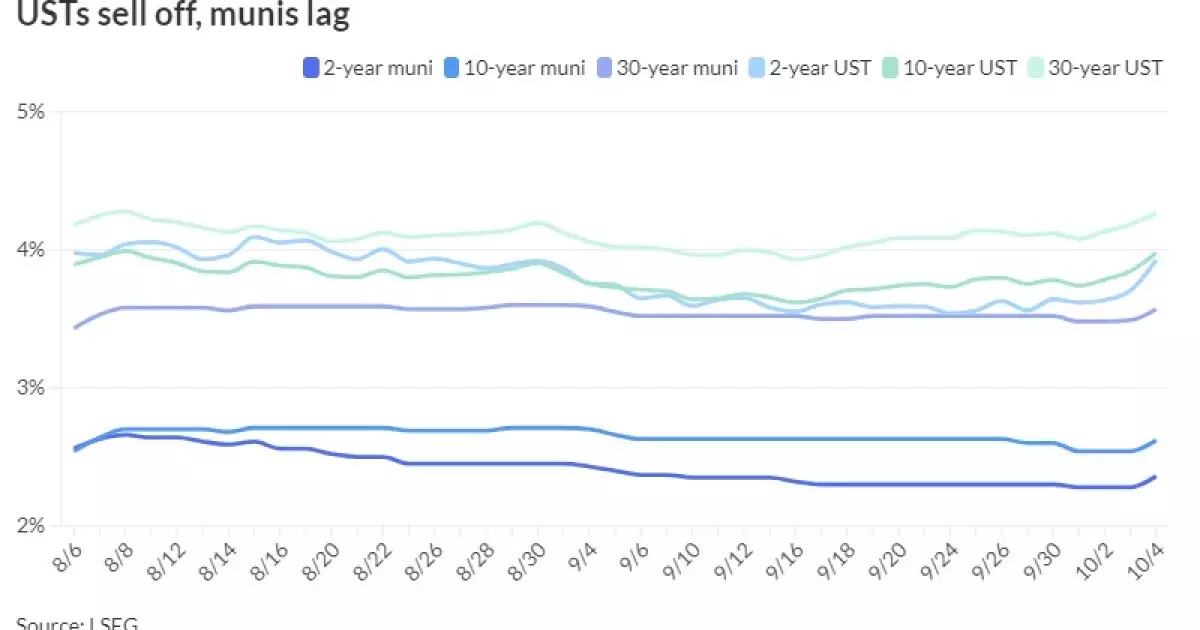On a recent Friday, the U.S. Treasury market experienced a notable sell-off driven by unexpectedly robust payroll data, a development that significantly shifted economists’ and traders’ expectations regarding future Federal Reserve interest rate cuts. The implications of this report reverberated across the financial landscape, with clear consequences for both the equities and municipal bond markets. Payrolls surged, prompting many to reassess the likelihood of further cuts to rates, particularly in light of the already recent rate adjustment—the first in over four years.
This unexpected increase in payroll figures presents a dual narrative. On one hand, it serves as a validation of the resilience of the U.S. economy, quelling fears of a deeper economic slowdown that might necessitate aggressive rate cuts. Conversely, it raises caution flags regarding inflationary pressures that could dissuade further monetary easing. Lara Castleton, the U.S. head of portfolio construction and strategy at Janus Henderson Investors, encapsulated this sentiment, stating that the “blowout jobs print” effectively recontextualizes the Federal Reserve’s recent moves to normalize interest rates as necessary for managing today’s economic climate.
The immediate impact of the strong employment figures rippled through the municipal bond market as well, where triple-A rated yields experienced an uptick. However, the municipal market outperformed its taxable counterparts, resulting in a compression of yields for tax-exempt bonds. The market witnessed a dynamic adjustment, with the ratio of municipal yields to U.S. Treasury yields dropping across various maturities. Such shifts reflect the inherent complexities in the municipal bond arena, one that often responds to immediate economic news but is also influenced by the broader macroeconomic context.
Barclays PLC noted that investors have largely shifted their focus to expectations of a modest 25 basis point cut rather than significant adjustments. This change in sentiment, spurred by strong payroll data and corroborating ISM and PMI reports, indicates a cautious approach to navigating the complicated landscape ahead. The yield hike in municipal securities came at a time when the bond market is bracing for a busy issuance calendar, which could introduce additional volatility.
The upward movement of the yield curve, especially within triple-A rated municipal bonds, suggests a complex interaction of demand, economic outlook, and supply chain factors in the fixed-income market. For instance, the two-year municipal-to-Treasury ratio settled around 58%, while longer tenors, such as the 30-year, adjusted to 82%. These figures outline the competitive nature of the municipal market amid macroeconomic shifts.
As noted by Mikhail Foux, managing director and head of municipal research and strategy at Barclays, there are emerging concerns about how tax-exempt bonds will cope with an influx of new issues—amounting to approximately $10 billion expected to come to market. With issuances led by substantial offerings from entities like New York City and Connecticut, the supply-demand imbalance could heighten, weighing on performance amid an already rich pricing environment for municipal bonds.
The equity markets responded positively to the upbeat payroll data, with major indices, including the Dow Jones, approaching historical highs. This increase underscores a broader narrative that investors are betting on sustained economic growth, further fueling their optimism despite the complications of an impending earnings season. The juxtaposition of the bond market’s cautious stance and the equities’ buoyancy exemplifies the challenges investors face in interpreting economic signals.
A reliable barometer for future economic health, the payroll report emerged as a critical influence, shifting perceptions and driving investment strategies across various asset classes. In doing so, it emphasizes the intricate links between labor market performance and the broader economic climate, alongside their combined effects on monetary policy expectations.
The aftermath of the strong U.S. payroll data presents both opportunities and challenges for investors. While the resilience of the job market ignites confidence in economic stability, it simultaneously complicates the outlook for monetary policy adjustments and creates a more volatile environment for fixed-income investments. As investors navigate this complex landscape, the decisions made in the coming weeks regarding rate expectations and portfolio positioning will be pivotal in shaping the trajectory of both the equity and municipal bond markets in the latter part of the year. The need for careful analysis and strategic foresight remains paramount as the economic narrative continues to unfold.

